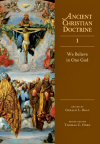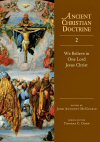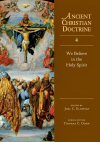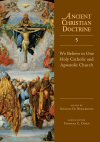Ancient Christian Doctrine Series (5 vols.)
Digital Logos Edition
From the earliest days of the Christian church, there has been the tendency to distill those essential aspects of Christian teaching into succinct creeds. These creeds, in turn, are unpacked to reveal much about the Christian understanding of the nature of God, salvation, and the church.
As the seminal Ancient Christian Commentary on Sacred Scripture series did for Scripture, so this series does for the classic articulation of Christian doctrine—the Nicene Creed. Following the outline set forth in that ancient creed, these volumes bring together copious amounts of commentary from the early church fathers on each statement and phrase. Fleshed out with commentary on the historical context and helpful indices, this collection makes it easy to see with the eyes of the early Christians and come to understand their vision of what it means to be Christian.
This title is included in the following collections
You can save when you purchase this product as part of a collection.
Verbum 9 Ordinariate Silver Le...
$349.99$349.99Theology Guide Feature Expansi...
$599.99$389.99Logos 8 Anglican Gold Legacy L...
$849.99$849.99Verbum 8 Ordinariate Gold Lega...
$849.99$849.99
- $849.99
- $849.99
- $1,074.99
- $1,828.49$1,099.99
- $1,499.99
- $1,499.99
- $2,999.99$2,249.99
- $2,999.99$2,249.99
- $15,739.84$2,360.50
- $2,499.99
- $2,999.99
- $2,999.99
- $2,999.99
- $2,999.99
- $4,749.99$3,562.49
- $3,999.99
- $4,749.99
- $4,749.99
- $4,749.99
- $4,749.99
- $7,749.99
- $7,749.99
- $13,731.48$10,219.99
- $14,013.38$11,199.99
- $11,399.99
- $23,999.99$17,999.99
- $21,749.99
- $24,999.99

- Thematically organizes key passages from the early church fathers regarding the essential Christian doctrines found in the Nicene Creed
- Provides commentary on the historical context from modern scholars
- Includes copious footnotes to point you to the wider context and further reading
The Ancient Christian Doctrine series allows us to think with the church about the deepest issues of the Christian faith. Tom Oden and his colleagues have done a superb job in leading us to the wellspring of Christian wisdom in these classic expositions of the evangelical and apostolic tradition. A treasury of learning and faith for all followers of Jesus today.
Timothy George, Founding Dean of Beeson Divinity School, Samford University, and General Editor of the Reformation Commentary on Scripture
As a professor of systematic theology I often seek to connect the teaching of the current church to the teaching of the church fathers. Tom Oden has done us all a great service in giving us the Ancient Christian Doctrine series, a wonderful sequel to the very successful Ancient Christian Commentary on Scripture. The current interest in the church fathers is a positive sign for me that many contemporary believers recognize that we must not be isolated in the twenty-first century from the faith once for all delivered to the saints (Jude 3), a faith that the fathers of the church sought to preserve and promulgate.
H. Wayne House, Distinguished Research Professor of Biblical and Theological Studies, Faith Evangelical Seminary, Tacoma, Washington
- Title: Ancient Christian Doctrine Series
- Publisher: IVP Academic
- Volumes: 5
- Pages: 1,221
- Resource Type: Monographs
- Topic: Doctrine of God
- We Believe in One God edited by Gerald L. Bray
- We Believe in One Lord Jesus Christ edited by John Anthony McGuckin
- We Believe in the Crucified and Risen Lord edited by Mark J. Edwards
- We Believe in the Holy Spirit edited by Joel C. Elowsky
- We Believe in One Holy Catholic and Apostolic Church edited by Angelo Di Berardino

“We believe in one God, the Father.” The opening clause of the Nicene Creed can be summed up in a single word—monotheism. In the early centuries of the church, this striking doctrine stood starkly against a cultural background of multiple deities and spiritual powers. While it clearly builds on its Jewish heritage, calling God “Father” anticipates the Father-Son relationship in the Godhead that early Christians knew and robustly upheld.
The first article of the Nicene Creed also presupposes that there is an objective body of teaching that Christians are expected to confess as their faith. This idea seems normal and natural to us, but it was a novelty in the ancient world. Neither Judaism nor any pagan religion or philosophy could claim to have a closely defined set of beliefs that everyone adhering to it was expected to profess publicly and defend against all comers.
While this article on God the Father is the shortest and arguably oldest portion of the Creed, it fully sets forth the fundamental understanding of God as creator and originator of all that is. This commentary in its selection of texts from the early church highlights the common understanding of the One God in three Persons, elucidating the church’s understanding of divine attributes and trinitarian relations.
A ‘standard doctrinal benchmark’ for modern Christians, both laity and clergy, of all Christian traditions. Recommended.
—J.P. Blosser, Choice, November 2009
Gerald L. Bray (PhD, La Sorbonne) is a professor at Beeson Divinity School of Samford University in Birmingham, Alabama, and director of research at Latimer Trust. He has written and edited a number of books on different theological subjects. A priest of the Church of England, Bray has also edited the post-Reformation Anglican canons.

“Who do you say that I am?” This question that Jesus asked of his disciples, so central to his mission, became equally central to the fledgling church. How would it respond to the Gnostics who answered by saying Jesus was less than fully human? How would it respond to the Arians who contended he was less than fully God? It was these challenges that ultimately provoked the Council of Nicaea in A.D. 325.
In this volume covering the first half of the article in the Nicene Creed on God the Son, John Anthony McGuckin shows how it countered these two errant poles by equally stressing Jesus' authentic humanity that is, his fleshliness and real embodiment in space and time and his spiritual glory or full divinity.
One cottage industry among some historical theologians, he notes, has been to live in a fever of conspiracy theory where orthodox oppressors dealt heavy-handedly with poor heretics. Or the picture is painted of ancient grassroots inclusivists being suppressed by establishment elites. The reality was far from such romantic notions. It was in fact the reverse.
The church who denounced these errors did so in the name of a greater inclusivity based on common sense and common education. The debate was conducted generations before Christian bishops could ever call on the assistance of secular power to enforce their views. Establishing the creeds was not a reactionary movement of censorship but rather one concerned with the deepest aspects of quality control.
Ultimately, what was and is at stake is not fussy dogmatism but the central gospel message of God’s stooping “down in mercy to enter the life of his creatures and share their sorrows with them. He has lifted up the weak and the broken to himself, and he healed their pain by abolishing their alienation.”
John Anthony McGuckin held the Nielsen Chair in Late Antique Christian History at Union Theological Seminary and was professor of Byzantine Christian Studies at Columbia University in New York City. He is an archpriest of the Romanian Orthodox Church, and rector of the Orthodox Church in Lytham St. Annes, England. He serves on the faculty of church history at Oxford University, and is a fellow of the Royal Historical Society of the United Kingdom.
McGuckin has been awarded several honorary doctorates, and has written twenty-five works of historical theology, including St. Cyril of Alexandria: The Christological Controversy, St. Gregory of Nazianzus: An Intellectual Biography, The Westminster Handbook to Patristic Theology, and The Ascent of Law.

The resurrection changed everything. “But for the resurrection,” writes Mark J. Edwards, “there would have been no reason to argue for a union of two natures in the person of Christ, let alone for a dyad or triad in the Godhead. All that he had said and done in the course of his earthly ministry would have sat well enough with the character of a prophet who excelled such predecessors as Isaiah and John the Baptist only in power and closeness to God.”
That is the story that unfolds as Edwards gathers together the most salient comments from the early church on the latter half of the second article of the Nicene Creed on God the Son as the crucified and risen Lord. The deliberations of ancient Christian writers on these matters are regarded now as the nucleus of Christology. The work of Christ is customarily considered, in Western Christendom at least, as the principal object of his coming. That Christ died for our sins was an axiom of all apostolic preaching.
In these pages we see that the doctrines of the Trinity and the incarnation were not the second thoughts of Christendom after its encounter with Greek philosophy. Rather they were forced on the church by its refusal to adopt the polytheism of the Greeks as a means of reconciling the sovereignty of God with the exaltation of Christ as Lord.
It is ultimately in the work of Christ that the essentials of his person are revealed. The church’s early teachers ultimately combine to denounce the critical maneuvers that would persuade us that the Scriptures do not mean what they plainly say. Here, as throughout the Creed, we see how the early church rooted all its claims in Scripture.
Mark J. Edwards is tutor in theology at Christ Church and university lecturer in patristics at the University of Oxford. Among his publications are Neoplatonic Saints, Origen Against Plato, John Through the Centuries, Constantine and Christendom, and Culture and Philosophy in the Age of Plotinus. He also served as the volume editor for Galatians, Ephesians, Philippians, New Testament volume 8 of the Ancient Christian Commentary on Scripture.

“The Spirit blows where it pleases,” Jesus said to Nicodemus. “You hear its sound but you cannot tell where it comes from or where it is going. So it is with everyone born of the Spirit.”
The Spirit, like the wind, is hard to pin down. Any discussion of the Spirit is fraught with the difficulty of speaking about something or someone who defies definition and who purposely averts attention from himself toward someone else. So it is with the Spirit. And so it is with the church’s reception of and conversation about the Spirit, even in its early centuries. It is hard to pin down, and the church’s voice on the Spirit has been about as loud as the whisper of the wind that indicates the Spirit’s presence.
The church’s teaching on the Holy Spirit is perhaps what Nicolas Berdayev has called “the last unexplored theological frontier.” In these latter days of the church, this “final frontier” is receiving increasing attention. The rise of the Pentecostal movement, the engaged witness of the Orthodox churches, which have historically been more sensitive to the role of the Spirit, coupled with the fact that people in general are looking for a deeper and more relational faith, perhaps help explain in part the increased attention the Spirit is getting.
It is appropriate then that the base camp of this exploration be established in the early understanding of the church on these matters. Following the outline of the succinct third article of the Nicene Creed, Joel Elowsky opens up to us vistas of the Holy Spirit with expertly selected passages from ancient Christian writings.
This portion of the Creed, apart from the filioque, is largely uncontroversial. The full deity of the Spirit is highlighted not so much by theological definition as by the emphasis on worship and action. While the Creed itself does not speak directly of the work of the Spirit in justification, sanctification and the like, the early church theologians nevertheless had much to say on these issues. Here we see clearly how the Spirit is “giver of life.”
The Rev. Dr. Joel C. Elowsky (PhD, Drew University) is associate professor of historical theology at Concordia Seminary, St. Louis. He has served as the operations manager for the Ancient Christian Commentary on Scripture and has edited the two volumes on John’s Gospel in that series. He is the volume editor for We Believe in the Holy Spirit in the Ancient Christian Doctrine series and has edited volumes on Theodore of Mopsuestia and Cyril of Alexandria in the Ancient Christian Texts series.

When was the church founded? Jesus spoke of the kingdom of God and not of a religious organization subsequently called church. We don’t find in the Gospels expressions which make reference to the foundation of a new religious community, a new and distinct community of followers of Jesus. But after the resurrection of Jesus, his followers, as a result of his express command, gather together not only those from the people of Israel but men and women of all nations.
The final clauses of the Nicene Creed spell out, briefly and to the point, the church’s self-understanding in these early centuries. Angelo Di Berardino assembles a wide range of texts and teachers of the church during these years to enrich our understanding and deepen our faith in the great mysteries expressed here.
The Creed quickly hits the four marks of the church—that it is “one, holy, catholic and apostolic.” What do we mean by professing each of these? Di Berardino helps us to give an answer with the help of the fathers of the church.
The volume closes, as does the Creed, with a consideration of baptism the traditional entrance for people into the church and two central features of the church in the future—the expectation that all of God’s people will enjoy the resurrection of the dead and the life of the world to come.
Angelo Di Berardino is past president and current professor of patrology at the Augustinian Patristic Institute (Augustinianum) in Rome. He is the editor or author of authoritative works on the early church, including Encyclopedia of the Early Church (recently updated and expanded in Italian as Nuovo dizionario patristico e di antichità cristiane) and Patrology: The Eastern Fathers from the Council of Chalcedon to John of Damascus. He also serves as the Italian-language editor for the Ancient Christian Commentary on Scripture.